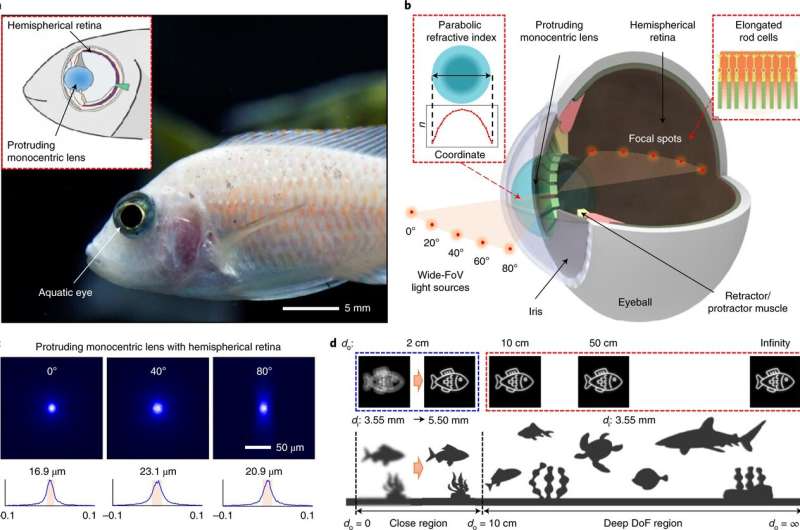July 1, 2020 report
A small, wide-field-of-view camera built based on fish eyes

A team of researchers affiliated with multiple institutions in South Korea and one from the U.S. has built a small, wide-field-of-view camera based on the structure of fish eyes. In their paper published in the journal Nature Electronics, the group describes their study of aquatic eyes in their search for a way to make smaller and lighter wide-field-of-view cameras and the development of the camera they made based on their findings.
Smartphone developers continue to conduct research into new features. One such feature may be wide-field-of-view cameras. Currently, such cameras require the use of several bulky lenses and are too heavy for use in small devices. To address these problems, the researchers turned their attention to aquatic eyes, specifically those in most fish. The researchers noted that fish eyes have a single lens and a curved retina, and are known to have wide-angle capabilities (up to 160 degrees). Most common fish are also known to have high visual acuity and a deep depth of field, all desired features in an artificial wide-field-of-view camera.
Inspired by their findings, the researchers set out to create a camera based on the structure of the fish eyes they had been studying. They built a core-shell type monocentric lens that had separate refractive indices for the shell and core. They also built a silicon nanorod photodiode in a hemispherical form that had a shape matching the focal plane of the monocentric lens. Putting the two parts together and adding an aperture in a customized housing resulted in a very small (and light) wide-field-of-vision imaging device.
Testing showed it to have optical characteristics that were comparable to current cameras with protruding lenses—it also had a 120-degree field of view and depth of field between 20 centimeters and infinity. The researchers took pictures with the camera, capturing images from wide angles at various distances. They suggest their work is a major step toward the development of wide-field-of-view cameras suitable for use in portable devices and drones.
More information: Min Sung Kim et al. An aquatic-vision-inspired camera based on a monocentric lens and a silicon nanorod photodiode array, Nature Electronics (2020). DOI: 10.1038/s41928-020-0429-5
© 2020 Science X Network
















